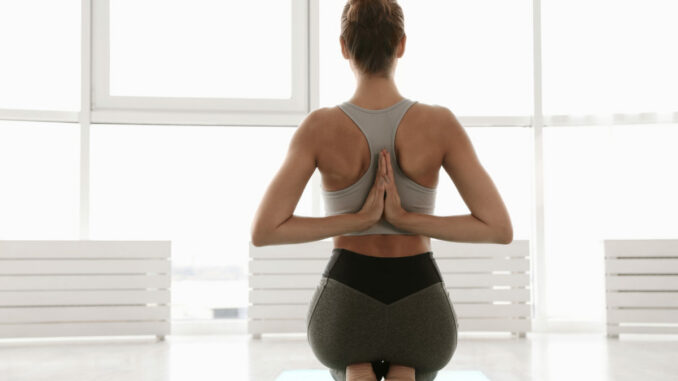
Introduction:
In the vast landscape of yoga, Reverse Prayer, or Paschim Namaskarasana, stands out as a unique and transformative pose. Rooted in the fusion of physicality and spirituality, Reverse Prayer is an asana that involves bringing the hands into a prayer position behind the back. In this comprehensive article, we delve into the intricacies of Reverse Prayer Yoga, exploring its technique, the profound benefits it offers for the body and mind, and its contribution to holistic well-being.
Technique of Reverse Prayer Yoga:
Step 1: Stand Tall and Relaxed
Begin in a comfortable, standing position with feet hip-width apart. Allow the shoulders to relax, and take a few deep breaths to center the mind.
Step 2: Bring Hands Together
Gently bring the hands together in a prayer position behind the back. Keep the fingers pointing downward, and if possible, touch the palms together.
Step 3: Gradual Movement
If initially challenging, use a strap or towel to bridge the gap between the hands. As flexibility increases, gradually work towards bringing the palms together.
Step 4: Lift and Open the Chest
As the hands come together, lift the chest and open the heart. Draw the shoulder blades together, creating a sense of expansion across the chest.
Step 5: Hold and Breathe
Hold the Reverse Prayer position for several breaths, maintaining a tall spine and feeling the stretch across the wrists, forearms, and shoulders.
Step 6: Release Mindfully
To release, slowly bring the hands back to the sides, allowing the shoulders to relax. Shake out the wrists if needed.
Benefits of Reverse Prayer Yoga:
1. Improved Shoulder Flexibility:
Reverse Prayer is a potent stretch for the shoulders and wrists, enhancing flexibility in these crucial joints. Regular practice can alleviate stiffness and tension, fostering greater mobility in the upper body.
2. Heart Opening and Chest Expansion:
The pose facilitates a profound opening of the heart center. As the chest expands, it counteracts the effects of poor posture and desk-bound lifestyles, promoting a more upright and aligned spine.
3. Enhanced Breathing Capacity:
The chest expansion in Reverse Prayer encourages deeper and more mindful breathing. By creating space in the chest, individuals may experience increased lung capacity and a greater ability to draw in nourishing breaths.
4. Alleviation of Tension and Stress:
The act of bringing the hands into Reverse Prayer position can have a calming effect on the nervous system. This pose may help alleviate tension in the upper back, neck, and shoulders, providing relief from stress-related discomfort.
5. Balancing Energy Flow:
In yogic philosophy, certain poses are believed to balance the flow of energy throughout the body. Reverse Prayer is thought to stimulate the Anahata (heart) chakra, fostering emotional balance and a sense of compassion.
6. Mind-Body Connection:
As with many yoga poses, Reverse Prayer encourages a deep connection between the mind and body. The intentional act of bringing the hands into prayer position invites a meditative quality to the practice, promoting mindfulness and presence.
7. Strengthening Core Muscles:
While often overlooked, maintaining the Reverse Prayer position requires engagement of the core muscles. This subtle strengthening contributes to overall stability and support for the spine.
8. Adaptability for Various Skill Levels:
Reverse Prayer can be modified to accommodate different skill levels. Using props, such as a strap or towel, allows beginners to gradually build flexibility and confidence in the pose.
Holistic Well-Being Through Reverse Prayer Yoga:
1. Emotional Release and Heart-Centeredness:
The heart-opening nature of Reverse Prayer is not limited to the physical body; it extends to emotional well-being. Many practitioners report feelings of emotional release, increased self-compassion, and a sense of residing in the heart space.
2. Postural Alignment and Spinal Health:
The chest expansion in Reverse Prayer contributes to improved posture and spinal alignment. As the pose counteracts the effects of hunching and slouching, it supports long-term spinal health.
3. Stress Reduction and Relaxation:
The meditative qualities of Reverse Prayer Yoga make it a valuable tool for stress reduction. The focused breathwork and intentional movements create a space for relaxation, aiding in the release of tension and mental stress.
4. Enhanced Mindfulness and Presence:
The integration of mindful breathing and intentional movement in Reverse Prayer encourages practitioners to be present in the moment. This heightened awareness can extend beyond the mat, contributing to a more mindful approach to daily life.
5. Cultivation of Mind-Body Harmony:
Yoga, at its core, seeks to cultivate harmony between the mind and body. Reverse Prayer exemplifies this harmony, providing a physical practice that extends into mental and emotional realms, fostering a sense of holistic well-being.
Precautions and Considerations:
- Individuals with wrist or shoulder injuries should approach Reverse Prayer with caution, modifying the pose or seeking guidance from a qualified yoga instructor.
- Beginners may use props or gradually work towards bringing the palms together behind the back.
- It’s crucial to listen to the body and avoid pushing into discomfort or pain.
Conclusion:
Reverse Prayer Yoga, with its graceful fusion of physicality and spirituality, stands as a testament to the holistic benefits of the ancient practice. From enhanced flexibility and improved posture to emotional release and stress reduction, this pose offers a multifaceted approach to well-being. As practitioners delve into the technique, embrace the benefits, and weave Reverse Prayer into their yoga journey, they embark on a path of self-discovery, balance, and profound connection between mind, body, and spirit.